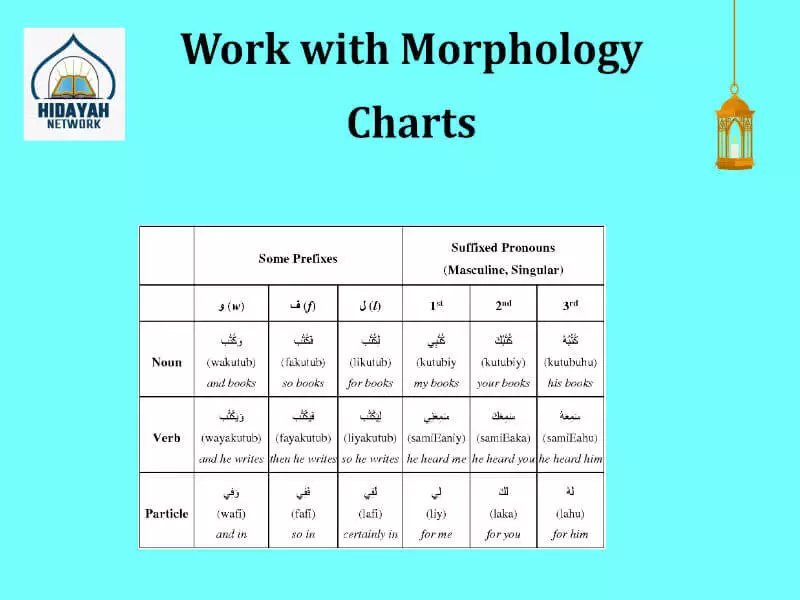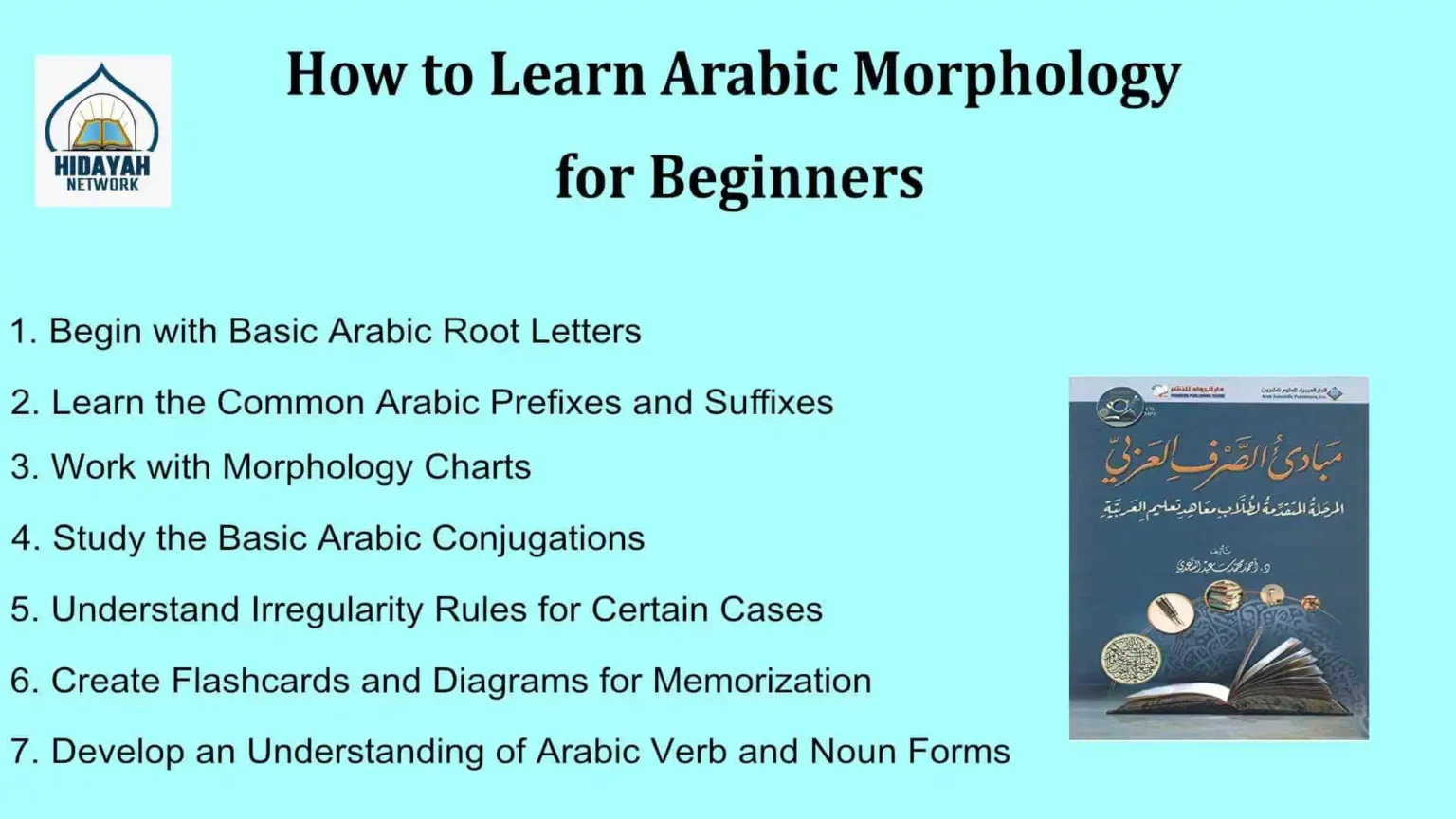Learning Arabic morphology can be an exciting experience for new learners. If you’re having trouble anticipating where to learn these complex elements, we can help you! We will share some tips for beginners to learn Arabic morphology that will make the learning process easier and more fun for you!
The best techniques to learn Arabic morphology for beginners include learning morphology through basic Arabic phrases, associating colors and umbers with patterns, beginning with basic Arabic root letters, learning the common Arabic prefixes and suffixes, understanding Arabic verb and noun forms, and more. In addition, there are more similar ways that can help you learn Arabic fast, which we will show you how. Let’s get going!
Table of Contents
ToggleWhat is Arabic Morphology?
Arabic morphology is like building with blocks. In Arabic words, we have special blocks called “root letters” (usually three of them) that carry the core meaning. To make new words, we add smaller blocks, like prefixes and suffixes, which change the meaning or tense.
When you learn how these blocks fit together, you can figure out the structure and meaning of Arabic words. It’s like solving a word puzzle. Arabic morphology helps us see how words are made and how they work in sentences.
11 Proven Ways to Learn Arabic Morphology for Beginners
Here are some of the most proven ways to learn read and speak Arabic for beginners:
1. Begin with Basic Arabic Root Letters
When starting your journey to learn Arabic morphology as a beginner, it’s crucial to understand the concept of trilateral root letters, the building blocks of Arabic words.
For instance, take the root letters “k-t-b,” which form the basis for words related to writing, like “kitab” (book) and “kataba” (he wrote). Starting with a few common root letters, like “k-t-b,” allows you to grasp the core structure of words in Arabic and makes it easier to expand your vocabulary by recognizing these roots in other words.
2. Learn the Common Arabic Prefixes and Suffixes
Learning common Arabic prefixes and suffixes is crucial for understanding word formations. Prefixes are added to the beginning of words, while suffixes are added at the end. These affixes often convey grammatical information, transforming a word’s meaning or indicating its function in a sentence.
Arabic Prefixes and Suffixes:
| Type | Example | Meaning |
| Prefix | “مُ-” (mu-) | Indicates the doer of the action |
| “نَـ” (na-) | Denotes the present tense | |
| Suffix | “-ين” (-een) | Indicates dual form |
| “-ة” (-ah) | Indicates feminine form |
Get 40% OFF Now!
3. Develop an Understanding of Arabic Verb and Noun Forms
Learning the various verb and noun forms in Arabic is a pivotal step for beginners. For instance, verbs can take on forms such as “fa’ala” (he did), “yaf’al” (he does), and “fa’ul” (the one who does). Nouns can exhibit forms like “kitab” (book) or “maktab” (a place for writing).
Recognizing these forms is essential in Arabic morphology because it enables you to conjugate verbs and create nouns with different meanings and functions, providing flexibility in your Arabic language usage. It’s an excellent way to speak and read Arabic fluently.
4. Study the Basic Arabic Conjugations
When you’re just starting with Arabic morphology, focusing on basic verb conjugations is immensely valuable. Learn how to conjugate verbs in the past, present, and future tenses, like “kataba” (he wrote), “yaktubu” (he writes), and “saya-k tubu” (he will write).
By grasping these fundamental conjugations, beginners can effectively express actions in different time frames, making communicating in Arabic easier. This practical approach is essential for mastering Arabic morphology from the ground up.
5. Understand Irregularity Rules for Certain Cases
Understanding irregularity rules in Arabic morphology involves recognizing exceptions to standard patterns in word formations. Some words deviate from regular conjugations or exhibit unique structures. Key irregularities include:
- Changes in root letters
- Unexpected vowel patterns
- And irregular verb forms.
To manage these irregularities:
- Be alert to variations in root letters, as some words undergo changes not conforming to standard patterns.
- Identify irregular vowel placements, especially in certain verb forms or conjugations.
- Recognize irregularities in verb forms that don’t follow typical conjugation patterns.
- Be aware of irregular noun forms with unique morphological structures.
6. Learn Morphology through Basic Daily Arabic Phrases
Learning morphology through basic daily Arabic phrases involves breaking down common expressions to understand the root letters, prefixes, and suffixes that form each word. Here’s a guide to mastering this approach:
Example Phrases:
Greetings:
Common Phrase: “As-salamu alaykum” (Peace be upon you)
Morphological Breakdown:
- Root Letters: S-L-M
- Prefix: “As-” (a form of the definite article)
- Suffix: “-u” (indicating the second person singular)
Expressing Gratitude:
Common Phrase: “Shukran” (Thank you)
Morphological Breakdown:
- Root Letters: Sh-K-R
Here’s how you can master each one:
- Begin with phrases that have minimal morphological complexities.
- Identify the root letters, prefixes, and suffixes in each word.
- Pronounce the phrases repeatedly to reinforce learning.
- Form new sentences using the learned phrases in different contexts.
7. Associate Colors and Numbers with Morphological Patterns
Associating colors and numbers with morphological patterns is a creative way to learn Arabic morphology. By assigning specific colors to root letters and numbers to prefixes or suffixes, you create a visual and numerical representation of word structures. Here’s a simple guide:
| Arabic Word | Morphological Breakdown | Colors for Root Letters | Numbers for Prefix/Suffix |
| “Kitab” (Book) | K – T – B | Red – Blue – Green | None |
| “Kataba” (He wrote) | K – T – B | Red – Blue – Green | 2 (Suffix: -a) |
| “Naktubu” (We write) | K – T – B | Red – Blue – Green | 1 (Prefix: Na-) |
Pro Tips: Start with simple words and gradually work towards more complex ones. Use markers or colored pens to physically highlight the root letters in your notes.
8. Build Basic Sentences with Morphological Structures and Forms
Building basic sentences with morphological structures in Arabic involves combining words using common verb and noun forms. Start with simple sentences to grasp the fundamentals. For instance, use the formula Subject + Verb + Object.
Example:
Sentence: “Ana atshaan.” (I am thirsty.)
Morphological Breakdown
- Subject: Ana (I)
- Verb: atshaan (am thirsty)
Here are pro tips to build sentences:
- Choose who or what the sentence is about (subject) and what is being affected (object).
- Pick a suitable verb form based on the subject and tense (present, past, future).
- Assemble the sentence by placing the subject, verb, and object in the correct order.
- Experiment with different verb forms, such as past tense (kataba – wrote) or future tense (sayaqtubu – will write).
9. Apply Morphology to Understand Quranic Arabic Texts
To apply morphology in understanding Quranic Arabic texts, focus on identifying root letters, prefixes, and suffixes within verses. Start by breaking down individual words and recognizing their morphological components.
For instance, in the phrase “Bismillah,” the root letters B-S-M (ب-س-م) signify “In the name of.” Additionally, grasp verb forms and conjugations to comprehend the context of actions mentioned in the Quran.
Expert Tip: Practice with commonly used phrases, such as “Alhamdulillah” (All praise be to Allah), to strengthen your morphological analysis.
10. Create Flashcards and Diagrams for Memorization
Creating flashcards and diagrams is an effective way to memorize Arabic morphology. For flashcards, consider the following:
1. Root Letters Flashcards
- Write the root letters on one side and their meanings on the other.
- Example: Front – “ك-ت-ب,” Back – “To write.”
2. Verb Forms Flashcards
- Display verb forms on one side and their English translations on the other.
- Example: Front – “يَكْتُبُ,” Back – “He writes.”
3. Prefixes and Suffixes Flashcards:
- Create cards for common prefixes and suffixes with explanations.
- Example: Front – “نَـ,” Back – “Prefix indicating ‘we.'”
11. Work with Morphology Charts

Morphology charts in Arabic break down word structures, depicting root letters, prefixes, and suffixes. To work with them:
- Locate the three root letters forming the core meaning of a word. “كتب” (katab – to write) has the root letters K-T-B.
- Recognize prefixes (at the beginning) and suffixes (at the end) influencing the word. “يكتب” (yaktub – he writes) has the prefix “ي” (ya-) and no suffix.
- Create a chart connecting root letters, prefixes, and suffixes to visualize word formation.7. Create charts for words like “درس” (darrasa – to study) or “كتاب” (kitaab – book).
Learn Arabic Morphology for Beginners From our Arabic Tutors
If you’re a beginner who is looking to start learning Arabic morphology, there’s no better platform than Hidayah Network to connect you with experienced Arabic tutors in our online Arabic classes for beginners. Our network of tutors provides comprehensive, personalized guidance to help you easily navigate the intricacies of Arabic morphology.
Whether you’re just starting or seeking to reinforce your understanding, our tutors can tailor their lessons to meet your needs. They will walk you through the fundamental concepts of trilateral root letters, common prefixes and suffixes, verb and noun forms, and even delve into the nuances of irregularities. Hidayah Network not only offers structured learning but also a supportive environment where you can ask questions, practice, and gain valuable insights.
- Hidayah Network connects you with seasoned Arabic tutors for in-depth guidance.
- Tailored lessons to meet your specific needs and learning pace.
- A welcoming environment for questions and practice fosters effective learning.
- Covers all aspects of Arabic morphology, from basics to complexities in our Arabic group classes.
- Accommodates your schedule for convenient, hassle-free learning experiences.
Final Words
Beginning on the journey of learning Arabic morphology as a beginner holds the promise of unlocking the beauty and richness of the Arabic language. As we’ve seen, understanding the trilateral root letters, common prefixes and suffixes, verb and noun forms, and even irregularities is a path to linguistic mastery.
With dedication and the right resources, you can explore the intricacies of Arabic word structure and embrace the challenges as opportunities to grow.
Most Important FAQs
The morphology pattern in Arabic is primarily based on trilateral root letters, typically three consonants, the core building blocks of words. These roots undergo various modifications by adding prefixes, suffixes, and vowel changes to create different word forms.
Basic Arabic morphology involves understanding the structure of Arabic words, focusing on trilateral root letters, prefixes, and suffixes. It’s the foundation for comprehending how words are formed and modified in Arabic.
There are five types of morphology: derivational morphology, inflectional morphology, agglutinative morphology, fusional morphology, and isolating morphology. These categories refer to different ways languages modify and create words.
A simple example of morphology is the word “unhappiness,” which is formed by adding the prefix “un-” to “happiness.” In this case, morphology shows how prefixes can change the meaning of a word.
Basic rules in morphology include understanding how prefixes and suffixes modify words, changing root letters to create different word forms, and recognizing patterns for verb conjugations and noun formations. These rules are crucial for deciphering the structure and meaning of words in a language.

About Author

